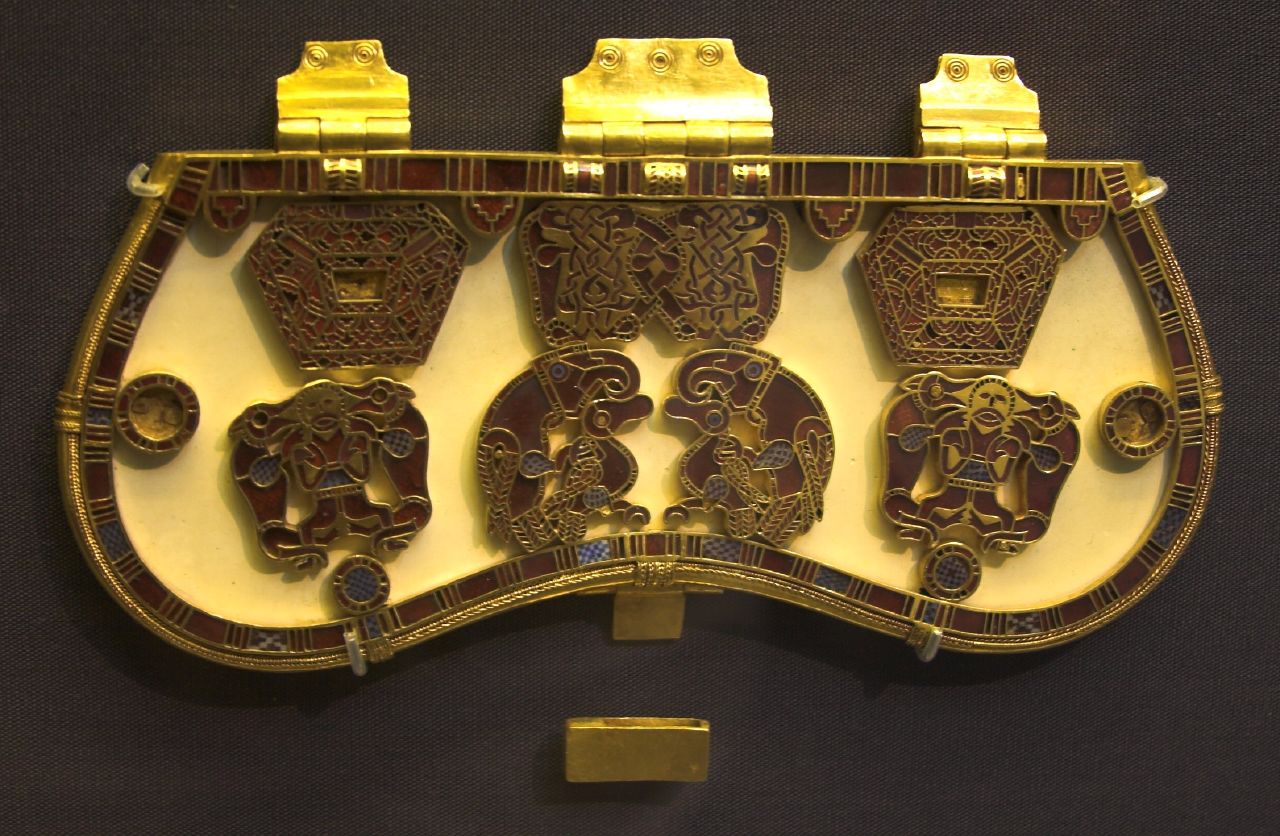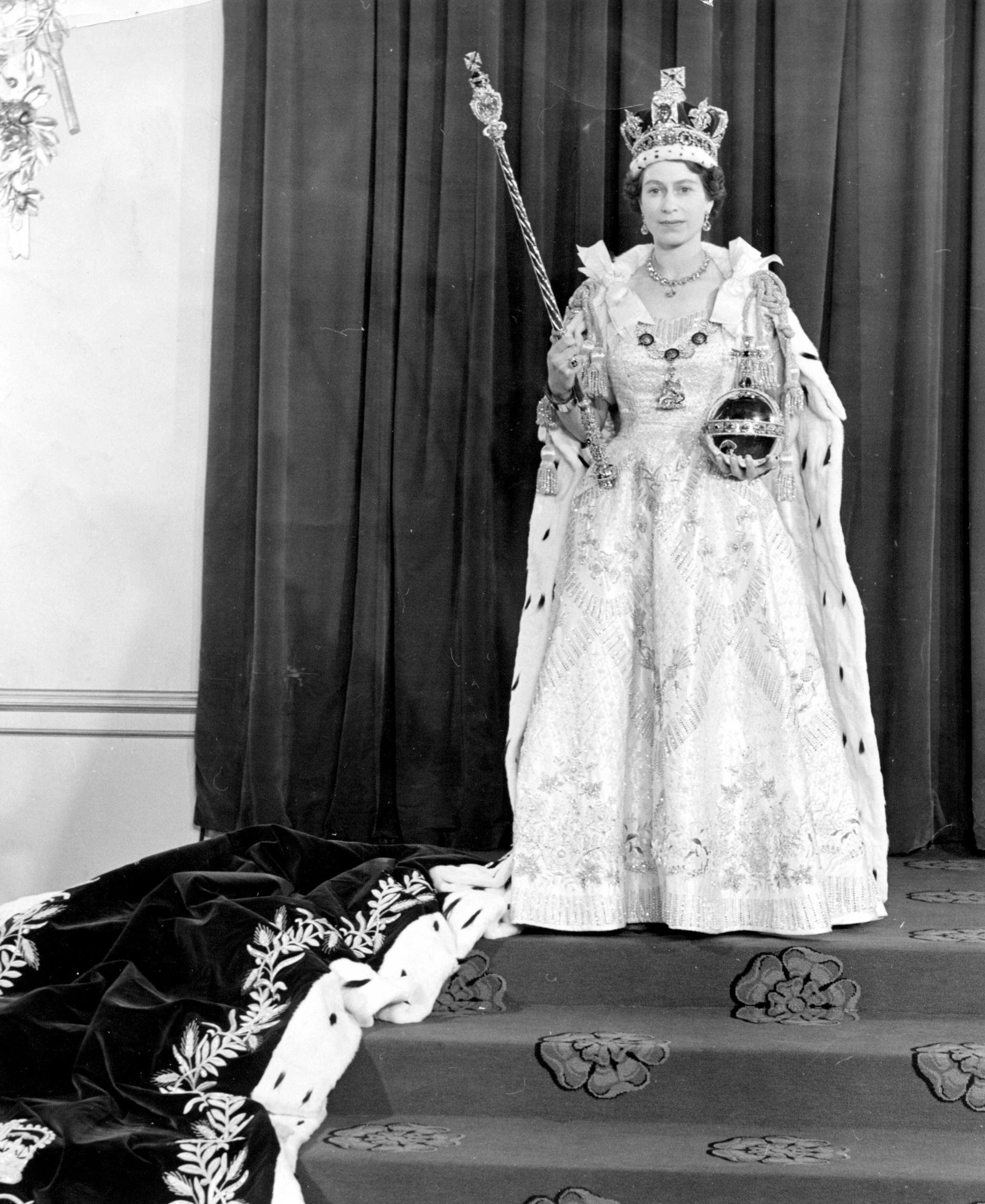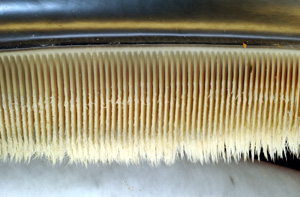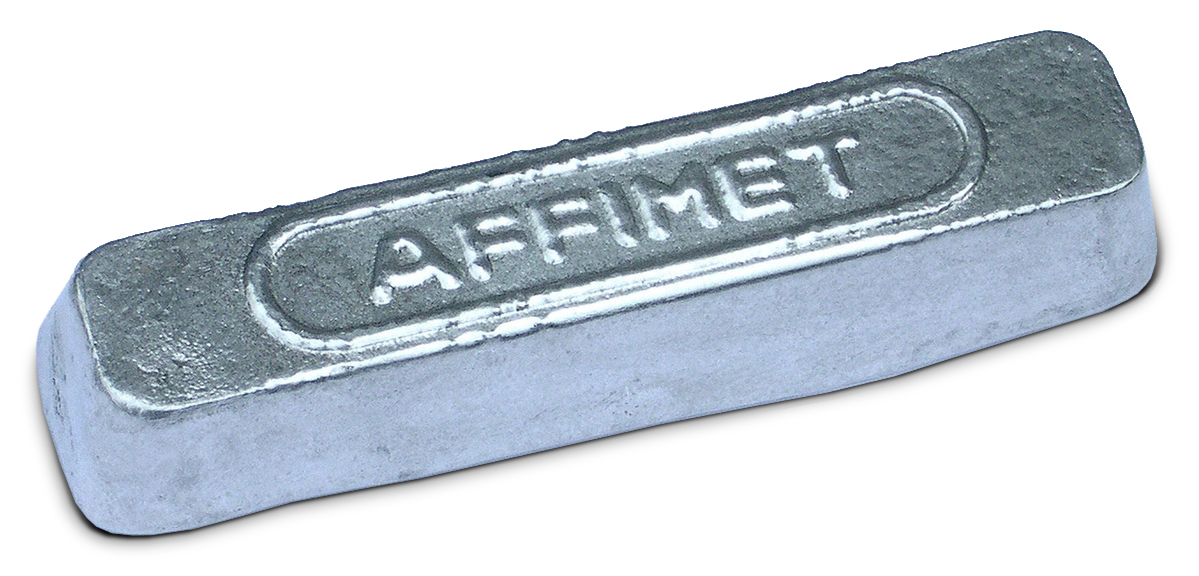|
Sutton Hoo Purse-lid
The Sutton Hoo purse-lid is one of the major objects excavated from the Anglo-Saxon royal burial-ground at Sutton Hoo in Suffolk, England. The site contains a collection of burial mounds, of which much the most significant is the undisturbed ship burial in Mound 1 containing very rich grave goods including the purse-lid. The person buried in Mound 1 is usually thought to have been Rædwald, King of East Anglia, who died around 624. The purse-lid is considered to be "one of the most remarkable creations of the early medieval period." About seven and a half inches long, it is decorated with beautiful ornament in gold and garnet cloisonné enamel, and was undoubtedly a symbol of great wealth and status. In 2017 the purse-lid was on display at the British Museum. Background The Roman legions withdrew from Britain in about 410 CE, by which time there is already evidence that groups of Germanic people were living alongside the native Romano-British population, probably as auxi ... [...More Info...] [...Related Items...] OR: [Wikipedia] [Google] [Baidu] |
Sutton
Sutton (''south settlement'' or ''south town'' in Old English) may refer to: Places United Kingdom England In alphabetical order by county: * Sutton, Bedfordshire * Sutton, Berkshire, a List of United Kingdom locations: Stu-Sz#Su, location * Sutton-in-the-Isle, Ely, Cambridgeshire * Sutton, Peterborough, Cambridgeshire * Sutton, Cheshire East, a civil parish in Cheshire ** Sutton Lane Ends, a village in Cheshire * Sutton, Middlewich, Cheshire * Sutton Weaver, Cheshire West and Chester * Great Sutton, Ellesmere Port, Cheshire * Guilden Sutton, Chester, Cheshire * Little Sutton, Cheshire, Ellesmere Port * Sutton on the Hill, Derbyshire * Sutton Scarsdale, Derbyshire * Sutton, Devon, a hamlet near Kingsbridge * Sutton, a historic name of Plymouth, Devon ** Sutton Harbour, Plymouth, Devon * Sutton Waldron, Dorset * Sutton, Essex * Long Sutton, Hampshire * Sutton Scotney, Hampshire * Sutton, Herefordshire * East Sutton, Kent * Sutton, Kent * Sutton-at-Hone and Hawley, Dartford, Kent ... [...More Info...] [...Related Items...] OR: [Wikipedia] [Google] [Baidu] |
Sub-Roman Britain
Sub-Roman Britain, also called post-Roman Britain or Dark Age Britain, is the period of late antiquity in Great Britain between the end of Roman rule and the founding of Anglo-Saxon kingdoms. The term was originally used to describe archaeological remains found in 5th- and 6th-century AD sites that hinted at the decay of locally made wares from a previous higher standard under the Roman Empire. It is now used to describe the period that began with the recall of Roman troops from Britannia to Gaul by Constantine III in 407 and ended with the Battle of Deorham in 577. This period has attracted a great deal of academic and popular debate, in part because of the lack of written records from the time. Meaning of terms The period of sub-Roman Britain traditionally covers the history of the parts of Britain that had been under Roman rule from the end of Roman imperial rule, traditionally dated to be in 410, to the arrival of Saint Augustine in 597. The date taken for the end ... [...More Info...] [...Related Items...] OR: [Wikipedia] [Google] [Baidu] |
Wuffingas
The Wuffingas, Uffingas or Wiffings were the ruling dynasty of East Anglia, the long-lived Anglo-Saxon kingdom which today includes the English counties of Norfolk and Suffolk. The Wuffingas took their name from Wuffa, an early East Anglian king. Nothing is known of the members of the dynasty before Rædwald, who ruled from about 599 to 624. The Viking invasions of the 9th century and Dissolution of the monasteries in the 16th century both led to the destruction of documents relating to the rule of the Wuffingas. The last of the Wuffingas kings was Ælfwald, who died in 749; he was succeeded by kings whose lineage is unknown. Earliest kings of the East Angles The Kingdom of East Anglia was invaded by peoples from northern Europe during the 5th and 6th centuries. Historical sources relating to the genealogy of the East Anglian kings include the ''Anglo-Saxon Chronicle'' and the 8th century English monk Bede's ''Ecclesiastical History'', both compiled many years after the k ... [...More Info...] [...Related Items...] OR: [Wikipedia] [Google] [Baidu] |
Master Of Animals
The Master of Animals, Lord of Animals, or Mistress of the Animals is a motif in ancient art showing a human between and grasping two confronted animals. The motif is very widespread in the art of Mesopotamia. The figure may be female or male, it may be a column or a symbol, the animals may be realistic or fantastical, and the human figure may have animal elements such as horns, an animal upper body, an animal lower body, legs, or cloven feet. Although what the motif represented to the cultures that created the works probably varies greatly, unless shown with specific divine attributes, when male the figure is typically described as a hero by interpreters. The motif is so widespread and visually effective that many depictions probably were conceived as decoration with only a vague meaning attached to them. The Master of Animals is the "favorite motif of Achaemenian official seals", but the figures in these cases should be understood as the king. The human figure may be stan ... [...More Info...] [...Related Items...] OR: [Wikipedia] [Google] [Baidu] |
Keratin
Keratin () is one of a family of structural fibrous proteins also known as ''scleroproteins''. It is the key structural material making up Scale (anatomy), scales, hair, Nail (anatomy), nails, feathers, horn (anatomy), horns, claws, Hoof, hooves, and the outer layer of skin in vertebrates. Keratin also protects epithelial cells from damage or stress. Keratin is extremely insoluble in water and organic solvents. Keratin monomers assemble into bundles to form intermediate filaments, which are tough and form strong mineralization (biology), unmineralized epidermal appendages found in reptiles, birds, amphibians, and mammals. Excessive keratinization participate in fortification of certain tissues such as in horns of cattle and rhinos, and armadillos' osteoderm. The only other biology, biological matter known to approximate the toughness of keratinized tissue is chitin. Keratin comes in two types: the primitive, softer forms found in all vertebrates and the harder, derived forms fou ... [...More Info...] [...Related Items...] OR: [Wikipedia] [Google] [Baidu] |
Iconography
Iconography, as a branch of art history, studies the identification, description and interpretation of the content of images: the subjects depicted, the particular compositions and details used to do so, and other elements that are distinct from artistic style. The word ''iconography'' comes from the Ancient Greek, Greek ("image") and ("to write" or ''to draw''). A secondary meaning (based on a non-standard translation of the Greek and Russian equivalent terms) is the production or study of the religious images, called "Icon, icons", in the Byzantine art, Byzantine and Eastern Orthodox Churches, Orthodox Christian tradition. This usage is mostly found in works translated from languages such as Greek or Russian, with the correct term being "icon painting". In art history, "an iconography" may also mean a particular depiction of a subject in terms of the content of the image, such as the number of figures used, their placing and gestures. The term is also used in many academic ... [...More Info...] [...Related Items...] OR: [Wikipedia] [Google] [Baidu] |
Roman Consul
The consuls were the highest elected public officials of the Roman Republic ( to 27 BC). Romans considered the consulship the second-highest level of the ''cursus honorum''an ascending sequence of public offices to which politicians aspiredafter that of the Roman censor, censor, which was reserved for former consuls. Each year, the Centuriate Assembly elected two consuls to serve jointly for a one-year term. The consuls alternated each month holding ''fasces'' (taking turns leading) when both were in Rome. A consul's ''imperium'' (military power) extended over Rome and all its Roman provinces, provinces. Having two consuls created a check on the power of any one individual, in accordance with the republican belief that the powers of the former King of Rome, kings of Rome should be spread out into multiple offices. To that end, each consul could veto the actions of the other consul. After the establishment of the Roman Empire, Empire (27 BC), the consuls became mere symboli ... [...More Info...] [...Related Items...] OR: [Wikipedia] [Google] [Baidu] |
Sceptre
A sceptre (or scepter in American English) is a Staff of office, staff or wand held in the hand by a ruling monarch as an item of regalia, royal or imperial insignia, signifying Sovereignty, sovereign authority. Antiquity Ancient Egypt and Mesopotamia The ''Was (sceptre), Was'' and other types of staves were signs of authority in Ancient Egypt. For this reason they are often described as "sceptres", even if they are full-length staffs. One of the earliest royal sceptres was discovered in the Second dynasty of Egypt, 2nd Dynasty tomb of Khasekhemwy in Abydos, Egypt, Abydos. Kings were also known to carry a staff, and Pharaoh Anedjib is shown on Stone vessels in Ancient Egypt, stone vessels carrying a so-called ''mks''-staff. The staff with the longest history seems to be the ''heqa''-sceptre (the "shepherd's crook"). The sceptre also assumed a central role in the Mesopotamian world, and was in most cases part of the royal insignia of sovereigns and gods. This continued thr ... [...More Info...] [...Related Items...] OR: [Wikipedia] [Google] [Baidu] |
Regalia
Regalia ( ) is the set of emblems, symbols, or paraphernalia indicative of royal status, as well as rights, prerogatives and privileges enjoyed by a sovereign, regardless of title. The word originally referred to the elaborate formal dress and accessories of a sovereign, but now it also refers to any type of elaborate formal dress. The word stems from the Latin substantivation of the adjective ''regalis'', "regal", itself from ''rex'', "king". It is sometimes used in the singular, ''regale''. In the abstract The term can refer to the rights, prerogatives, and privileges that are held exclusively by any sovereign, regardless of title (emperor, grand duke, etc.). An example of that is the right to mint coins, and especially coins that bear one's own effigy. In many cases, especially in feudal societies and generally weak states, such rights have in time been eroded by grants to, or usurpations by, lesser vassals. Royal dress, accessories, and associated pomp Some emblem ... [...More Info...] [...Related Items...] OR: [Wikipedia] [Google] [Baidu] |
Whalebone
Baleen is a filter-feeding system inside the mouths of baleen whales. To use baleen, the whale first opens its mouth underwater to take in water. The whale then pushes the water out, and animals such as krill are filtered by the baleen and remain as a food source for the whale. Baleen is similar to bristles and consists of keratin, the same substance found in human fingernails, skin and hair. Baleen is a skin derivative. Some whales, such as the bowhead whale, have baleen of differing lengths. Other whales, such as the gray whale, only use one side of their baleen. These baleen bristles are arranged in plates across the upper jaw of whales. Depending on the species, a baleen plate can be long, and weigh up to . Its hairy fringes are called baleen hair or whalebone hair. They are also called baleen bristles, which in sei whales are highly calcified, with calcification functioning to increase their stiffness. Baleen plates are broader at the gumline (base). The plates have be ... [...More Info...] [...Related Items...] OR: [Wikipedia] [Google] [Baidu] |
Mint (facility)
A mint is an industrial facility which manufactures coins that can be used as currency. The history of mints correlates closely with the history of coins. In the beginning, hammered coinage or cast coinage were the chief means of coin minting, with resulting production runs numbering as little as the hundreds or thousands. In modern mints, coin dies are manufactured in large numbers and planchets are made into milled coins by the billions. With the mass production of currency, the production cost is weighed when minting coins. For example, it costs the United States Mint much less than 25 cents to make a quarter (a 25 cent coin), and the difference in production cost and face value (called seigniorage) helps fund the minting body. Conversely, a U.S. penny ($0.01) cost $0.015 to make in 2016. History The first minted coins The first mint was likely established in Lydia in the 7th century BC, for coining gold, silver and electrum. The first coins known to be minte ... [...More Info...] [...Related Items...] OR: [Wikipedia] [Google] [Baidu] |
Ingot
An ingot is a piece of relatively pure material, usually metal, that is Casting, cast into a shape suitable for further processing. In steelmaking, it is the first step among semi-finished casting products. Ingots usually require a second procedure of shaping, such as cold/hot working, cutting, or milling to produce a useful final product. Non-metallic and semiconductor materials prepared in bulk form may also be referred to as ingots, particularly when cast by mold based methods. Precious metal ingots can be used as currency (with or without being processed into other shapes), or as a currency reserve, as with gold bars. Types Ingots are generally made of metal, either pure or alloy, heated past its melting point and cast into a bar or block using a mold chill method. A special case are polycrystalline or single crystal ingots made by pulling from a molten melt. Single crystal Single crystal ingots (called boule (crystal), boules) of materials are grown (crystal growth) using ... [...More Info...] [...Related Items...] OR: [Wikipedia] [Google] [Baidu] |










